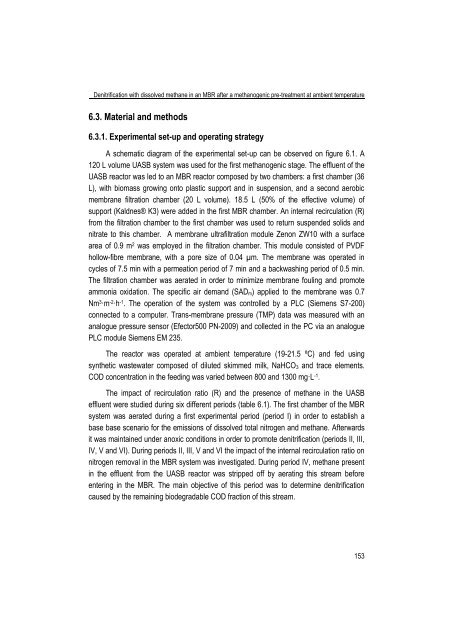Combining submerged membrane technology with anaerobic and ...
Combining submerged membrane technology with anaerobic and ...
Combining submerged membrane technology with anaerobic and ...
You also want an ePaper? Increase the reach of your titles
YUMPU automatically turns print PDFs into web optimized ePapers that Google loves.
Denitrification <strong>with</strong> dissolved methane in an MBR after a methanogenic pre-treatment at ambient temperature6.3. Material <strong>and</strong> methods6.3.1. Experimental set-up <strong>and</strong> operating strategyA schematic diagram of the experimental set-up can be observed on figure 6.1. A120 L volume UASB system was used for the first methanogenic stage. The effluent of theUASB reactor was led to an MBR reactor composed by two chambers: a first chamber (36L), <strong>with</strong> biomass growing onto plastic support <strong>and</strong> in suspension, <strong>and</strong> a second aerobic<strong>membrane</strong> filtration chamber (20 L volume). 18.5 L (50% of the effective volume) ofsupport (Kaldnes® K3) were added in the first MBR chamber. An internal recirculation (R)from the filtration chamber to the first chamber was used to return suspended solids <strong>and</strong>nitrate to this chamber. A <strong>membrane</strong> ultrafiltration module Zenon ZW10 <strong>with</strong> a surfacearea of 0.9 m 2 was employed in the filtration chamber. This module consisted of PVDFhollow-fibre <strong>membrane</strong>, <strong>with</strong> a pore size of 0.04 µm. The <strong>membrane</strong> was operated incycles of 7.5 min <strong>with</strong> a permeation period of 7 min <strong>and</strong> a backwashing period of 0.5 min.The filtration chamber was aerated in order to minimize <strong>membrane</strong> fouling <strong>and</strong> promoteammonia oxidation. The specific air dem<strong>and</strong> (SAD m) applied to the <strong>membrane</strong> was 0.7Nm 3·m -2·h -1 . The operation of the system was controlled by a PLC (Siemens S7-200)connected to a computer. Trans-<strong>membrane</strong> pressure (TMP) data was measured <strong>with</strong> ananalogue pressure sensor (Efector500 PN-2009) <strong>and</strong> collected in the PC via an analoguePLC module Siemens EM 235.The reactor was operated at ambient temperature (19-21.5 ºC) <strong>and</strong> fed usingsynthetic wastewater composed of diluted skimmed milk, NaHCO 3 <strong>and</strong> trace elements.COD concentration in the feeding was varied between 800 <strong>and</strong> 1300 mg·L -1 .The impact of recirculation ratio (R) <strong>and</strong> the presence of methane in the UASBeffluent were studied during six different periods (table 6.1). The first chamber of the MBRsystem was aerated during a first experimental period (period I) in order to establish abase base scenario for the emissions of dissolved total nitrogen <strong>and</strong> methane. Afterwardsit was maintained under anoxic conditions in order to promote denitrification (periods II, III,IV, V <strong>and</strong> VI). During periods II, III, V <strong>and</strong> VI the impact of the internal recirculation ratio onnitrogen removal in the MBR system was investigated. During period IV, methane presentin the effluent from the UASB reactor was stripped off by aerating this stream beforeentering in the MBR. The main objective of this period was to determine denitrificationcaused by the remaining biodegradable COD fraction of this stream.153
















